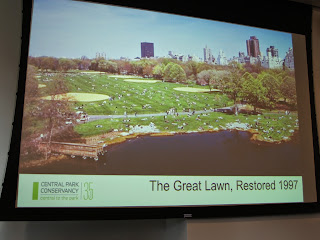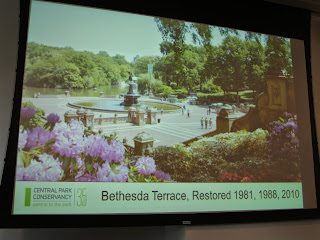Today we visited a place which is described as an iconic living museum -the New York Botanical Garden. The 250 acre National Historic Landmark is located in the Bronx, North of Manhattan, and is accessed easily via a train which conveniently stops outside of the public entrance. On arrival we received a brief overview of the garden, including an outline of their three main objectives - science, horticulture and art, before starting our tour.
The garden welcomes nearly a million visitors a year, which is impressive given it's distant proximity to Central New York.
Renound for it's science faculty, we first visited the Herbarium. Director of The School of Professional Horticulture, Charles Yurgalevitch, had arranged an all encompassing itinerary for us and acted as our chaperone for the first half of the day.
Tom Zanoni, who works in the vast herbarium at NYBG, was kind enough to discuss their collection and show us a few of their specimens. Their collection is the largest in the Western Hemisphere with over 7 million samples, and includes many type specimens. The herbarium itself was magnificent, state of the art, and was housed over four stories.
We were then escorted to the library to meet Steve Sinon. The library has the worlds largest collection of books on botany, horticulture and landscape design all under one roof. They had a fantastic area of 'rare works' which included scores of original Darwin works, as well as a first edition of Linnaeus' Species Plantarum.
We met with some of the first year NYBG students for lunch and talked about our respective courses and institutes. NYBG have an unparalleled array of certificate courses available - from botany to horticultural therapy.
After lunch we were escorted around the Perennial Garden. It was an area which was meticulously tidy and it surprised a lot of us. 'It wouldn't look out of place at chanticleer' and 'this might be the best perennial garden we've seen this trip' were just two quotes - my photo doesn't really do it justice. It looked phenomenal, particularly when you consider the time of year.
NYBG has recently had a native plant garden installed, blending the character of the plants with a more contemporary twist. After seeing them at Mout Cuba last week, a garden which almost perfectly imitates their natural environment outside of the wild, it was great to see them used in a more innovative, contemporary way.
50 acres of original native New York woodland exist within the confines of the garden. They have been managed in a way that ensures minimal invasion from exotics and encourages the natural recolonisation of native plants. Originally containing lots of western hemlock, they have since been struck by a wooly adelgid epidemic and have struggled since. Their now dwindling numbers are gradually being replaced by tulip trees, oaks and other native trees which have taken advantage of the vacant space.
The garden has numerous areas of interest, including the rock garden (a personal favourite of mine - see picture) which contained genuine alpine plants and a picturesque waterfall, as well as a magnificent conservatory and a phenomenally diverse range of plants spread throughout the garden.
The azalea garden is also extremely good with the geology of the garden adding to the overall spectacle. Rocks protrude above the soil surface like mineralised icebergs and effortlessly improve the immediate landscape and everything which surrounds them. The garden design and plant selection accounts for this and it is by no means coincidental.
They also had the most impressive garden gift shop I've ever seen and a novel tram tour service. Sadly I didn't have the time to experience it!
It was a very memorable visit, and if you ever get the chance to go I would highly recommend it. It oozes class and is maintained to as high a standard as I've seen in any garden on our trip. That says a lot when you consider it is a 250 acre botanic garden.
Brendan Arundel, 12.05.15

















































